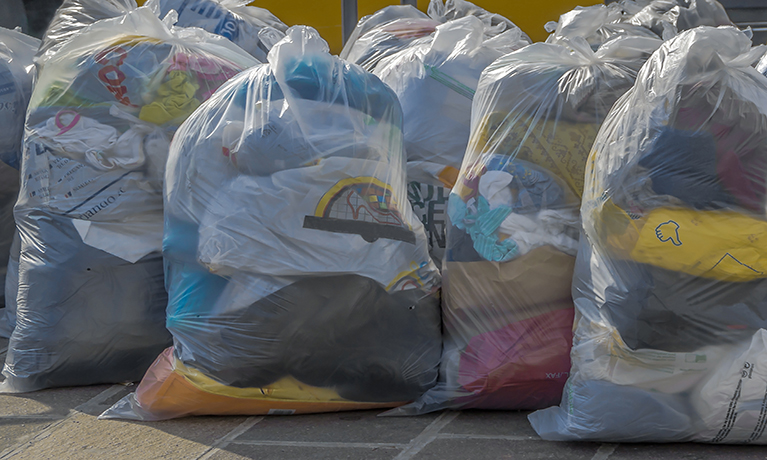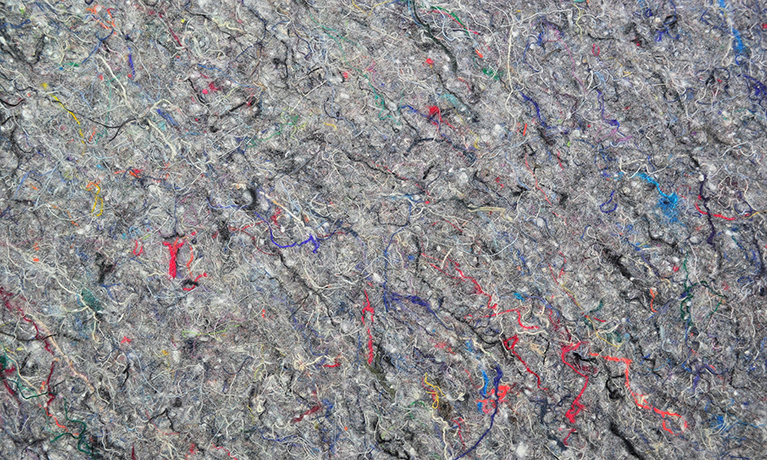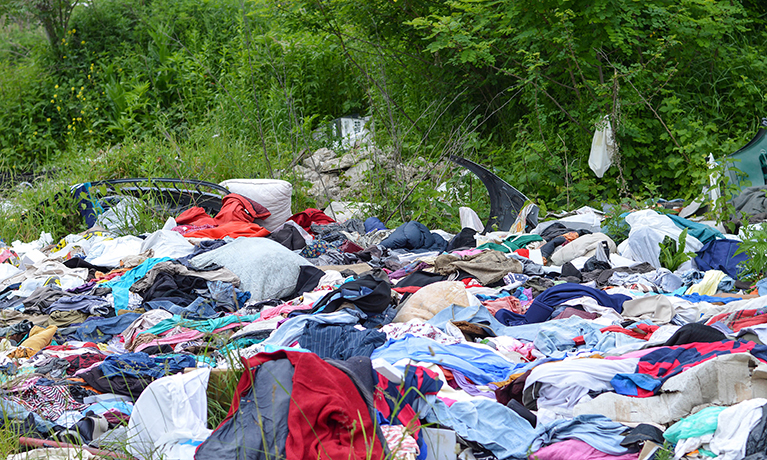When you think of Finland what comes to mind? Lapland, Santa Claus and snow? Saunas, reindeers, clean air and Nokia? How about an advanced technology that turns unwanted textiles from discarded garments into clothing fibre to make new items of clothing? Textile exchange. Petri Alava, a Finnish start-up entrepreneur and Chief Executive at Infinited Fiber, has developed a technology called Infinna (BBC, 2022). Infinited Fiber is founded upon a patented technology (Infinna) that prevents worn and damaged clothing from ending up at landfill or from being burnt. Instead, the old textiles are converted into premium-quality fibres for the textile industry (Infinited Fibre, 2022). The fibre feels and looks like cotton, scientifically coined as ‘cellulose carbamate fibre’. It contributes to the call by consumers, activists, policy makers and a number of fashion brands for a fashion industry that fosters a circular economy.
Environmental Impacts of the Fashion Industry
The Ellen Macarthur Foundation (2022a) reports the huge waste of the fashion industry, revealing that less than 1% of clothing is recycled, leading to the equivalent of a truck load of clothing being sent to landfill or burnt every second. The fashion industry is one of the most wasteful industries in the world due to the advent of fast fashion fostering consumers’ desire for low-cost and trendy clothes on a daily basis (Brydges, 2021). Leading to a linear business model of extracting, manufacturing and disposing of textiles at an alarming rate (Hugo et al., 2021). In a recent study (Marques et al., 2020) found that only 20% of clothing globally is collected for recycling and reusing, with the outstanding 80% incinerated and sent to landfill, leading to a heavy carbon footprint and losses of raw materials and energy. Further environmental costs of clothing being sent to landfill are groundwater pollution derived from toxic leachate and methane emissions (Han et al., 2017). The circular economy business models, such as repair, reuse, recycle and rent (Ellen Macarthur Foundation, 2022b), have gained prominence in the fashion industry as way of ‘turning their back’ on traditional wasteful business models.

The Circular Economy
The concept of the circular economy is a framework that has been gaining traction in recent years, as a model for businesses to integrate in the aim of becoming more sustainable and for the purpose of acting as a closed-loop economy to reduce a wasteful fashion industry (Brydges, 2021). This alternative economic model to the traditional ‘fabrication, use and dispose’ promotes companies to keep resources in a loop for as long as possible, whilst retaining value of the product during use and repurposing into new products as the original utilisation comes to an end (Shirvanimoghaddam et al., 2020).
In recent studies, scholars investigating the fashion industry and the circular economy have focused on the scope of industry actions aligned to consumption and waste, and how the circular economy business models can reduce fashion’s environmental impact (Brydges, 2021). Some examples include take-back garment programmes (Kant Hvass and Pedersen, 2019), swapping clothes (Henninger et al., 2019), repair services (Stal and Jansson, 2017) and clothing libraries (Zamani et al., 2017).
Infinited Fiber is a novel start-up that boasts a circular economy framework with the use of technology contributing to the reuse and recycle business models. With the European Union’s textile waste recycling scheme becoming mandatory by 2025 (European Clothing Action Plan, 2022), there is scope for the Infinna technology to become a mainstream technology to minimise the fashion industry’s wasteful habits. So, what is the future of Infinna? Are they here to stay?

Closing the Loop: The Future of Infinna Technology
Finland’s call for reusing and saving resources places Infinited Fiber’s aims and ambitions for a circular and more sustainable option to traditional textile fibers as a key player in the country’s wider vision (BBC, 2022; Infinited Fibre, 2022). The company already has secured backing from interested stakeholders, which has led to a €400m investment into their first commercial-scale factory. The ambition is to create 30,000 tonnes of fibre a year once operating at a full capacity by 2025. This is comparable to 100 million T-shirts (BBC, 2022). Highstreet fashion brands such as Zara, H&M and Patagonia are already using Infinna technology in their clothing ranges. The company wants to work with high street clothing brands that are becoming more concerned with the fashion industry’s impact on the environment, in the hope of addressing consumers seeking more sustainable shopping (BBC, 2022).
Where Next?
Infinited Fiber’s Chief Executive has discussed diversification to strengthen its position and help further with the issues of waste. Infinited Fiber wants to enter the non-wovens industry, which created nappies and wet wipes that are single-use, by using Infinna’s micro-plastic free and biodegradable fiber (Forbes, 2022). This is potentially very good news for landfill and environmental pressures.
However, behavioural change is a barrier to the company’s success. The company encourages consumers to take their clothes to their nearest textile collection point. Past studies, though, show that consumers who demonstrate environmental concern do not necessarily translate their concerns into changed behaviours and decision making. It will be interesting to see how Infinited Fiber will overcome such behavioural barriers.
The future of sustainable fashion and the use of circular economy business models to cut emissions, waste and environment damage of the fashion industry look encouraging. Infinna is most definitely a start-up paving the way for fruitful collaboration between technology and the circular economy framework, to the benefit of society. The huge waste associated with the clothing industry and fast fashion requires such innovation. Let us hope that consumers will make the extra effort required to return their unwanted clothing and that more brands will use the recycled fibre in production of their ranges.
References
BBC (2022), Finland wants to transform how we make clothes. [online] Available from < https://www.bbc.co.uk/news/business-62806565> [30/09/2022].
Brydges, T. (2021), “Closing the loop on take, make, waste: Investigating circular economy practices in the Swedish fashion industry,” Journal of Cleaner Production, 293, p. 126245.
Ellen Macarthur Foundation (2022a), Redesigning the Future of Fashion. [online] Available from < https://ellenmacarthurfoundation.org/topics/fashion/overview> [30/09/2022].
Ellen Macarthur Foundation (2022b), Vision of a Circular Economy for Fashion. [online] Available from < https://emf.thirdlight.com/link/nbwff6ugh01m-y15u3p/@/preview/1?o> [30/09/22].
European Clothing Action Plan (2022), Improving European Clothing Collection Rates. [online] Available from < http://www.ecap.eu.com/take-action/increasing-clothing-recovery-rates-2/> [30/09/22].
Forbes (2021), How Infinited Fiber Company Is Turning Trash Into Textiles—And Pioneering A Truly Circular Fashion Economy. [online] Available from <https://www.forbes.com/sites/afdhelaziz/2021/04/21/how-infinited-fiber-company-is-turning-trash-into-textilesand-pioneering-a-truly-circular-fashion-economy/?sh=7f784c8a1017> [02/10/2022].
Han, S.L., Chan, P.Y., Venkatraman, P., Apeagyei, P., Cassidy, T. and Tyler, D.J. (2017), “Standard vs. upcycled fashion design and production”, Fashion Practice, 9 (1), pp.69-94.
Henninger, C.E., Bürklin, N. and Niinimäki, K. (2019), “The clothes swapping phenomenon–when consumers become suppliers”, Journal of Fashion Marketing and Management: An International Journal.
Hugo, A.de A., de Nadae, J. and Lima, R.da S. (2021), “Can fashion be circular? A literature review on circular economy barriers, drivers, and practices in the fashion industry’s productive chain,” Sustainability, 13 (21), p. 12246.
Infinited Fibre (2022), Our Technology. [online] Available from < https://infinitedfiber.com/our-technology/> [30/09/22].
Kant Hvass, K. and Pedersen, E.R.G. (2019), “Toward circular economy of fashion,” Journal of fashion Marketing and Management, 23(3), pp. 345–365.
Marques, A.D., Marques, A. and Ferreira, F. (2020), “Homo Sustentabilis: Circular economy and new business models in fashion industry”, SN Applied Sciences, 2 (2), pp.1-5.
Shirvanimoghaddam, K. et al. (2020), “Death by waste: Fashion and textile circular economy case”, The Science of the Total Environment, 718, p. 137317.
Stål, H.I. and Jansson, J. (2017), “Sustainable consumption and value propositions: Exploring product–service system practices among Swedish fashion firms”, Sustainable Development, 25 (6), pp.546-558.
Zamani, B., Sandin, G. and Peters, G.M. (2017), “Life cycle assessment of clothing libraries: Can collaborative consumption reduce the environmental impact of fast fashion?”, Journal of Cleaner Production, 162, pp.1368-1375.
Through understanding the impact of organisations’ activities, behaviours and policies, the Centre for Business in Society at Coventry University seeks to promote responsibility, to change behaviours, and to achieve better outcomes for economies, societies and the individual.




Comments are disabled